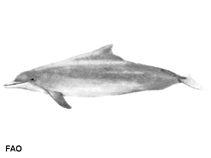Sousa chinensis (Osbeck, 1765)
Pacific humpback dolphin
Classification / Names Common names | Synonyms | CoL | ITIS | WoRMS
Mammalia | Cetartiodactyla | Delphinidae
Environment: milieu / climate zone / depth range / distribution range Ecology
Pelagic-oceanic; amphidromous (Ref. 75906); brackish; depth range 0 - 500 m, usually 1 - 100 m. Tropical; 90°N - 90°S, 18°E - 155°E
Distribution Countries | FAO areas | Ecosystems | Occurrences | Introductions
Indo-West Pacific. [eastern Taiwan Strait population: IUCN 2017 (Ref. 115185): CR, C2a(i,ii); D.]
Length at first maturity / Size / Weight / Age
Maturity: Lm 235.0, range 200 - 250 cm Max length : 320 cm TL male/unsexed; (Ref. 1394); 250 cm TL (female); max. published weight: 284.0 kg (Ref. 1394)
Inhabit tropical to warm temperate coastal waters and they enter rivers, estuaries, and mangroves. Feeding is primarily on nearshore, estuaries and reef fish (Ref. 1394). Inhabits tropical to warm temperate coastal waters and they enter rivers, estuaries, and mangroves (Ref. 1394). Usually in groups of 10 or fewer individuals (Ref. 801). Feeding is primarily on nearshore, estuaries, specifically on reef fish (Ref. 1394). Feeds on bony fishes (Ref. 85079) and squids (Ref. 80529). Great white shark Carcharodon carcharias is reported to be its potential predator (Ref. 104929).
Life cycle and mating behavior Maturity | Reproduction | Spawning | Eggs | Fecundity | Larvae
Main reference
References | Coordinator | Collaborators
Jefferson, T.A., S. Leatherwood and M.A. Webber. 1993. (Ref. 1394)
IUCN Red List Status (Ref. 130435)
Vulnerable (VU) (A3cd+4cd); Date assessed: 22 June 2015
CITES status (Ref. 108899)
Appendix I: International trade banned
CMS (Ref. 116361)
Appendix II: Migratory species conserved through agreements
Threat to humans
Human uses
Fisheries: commercial
FAO - Fisheries: landings, species profile | FishSource | Sea Around Us
Tools
More information
Internet sources
BHL | BOLD Systems | CISTI | DiscoverLife | FAO(Fisheries: species profile; publication : search) | Fishipedia | GenBank (genome, nucleotide) | GloBI | Gomexsi | Google Books | Google Scholar | Google | PubMed | Tree of Life | Wikipedia (Go, Search) | Zoological Record
Estimates based on models
Preferred temperature
(Ref. 115969): 22.2 - 29.1, mean 27.9 (based on 4436 cells).
Price category
(Ref. 80766):
Unknown.



